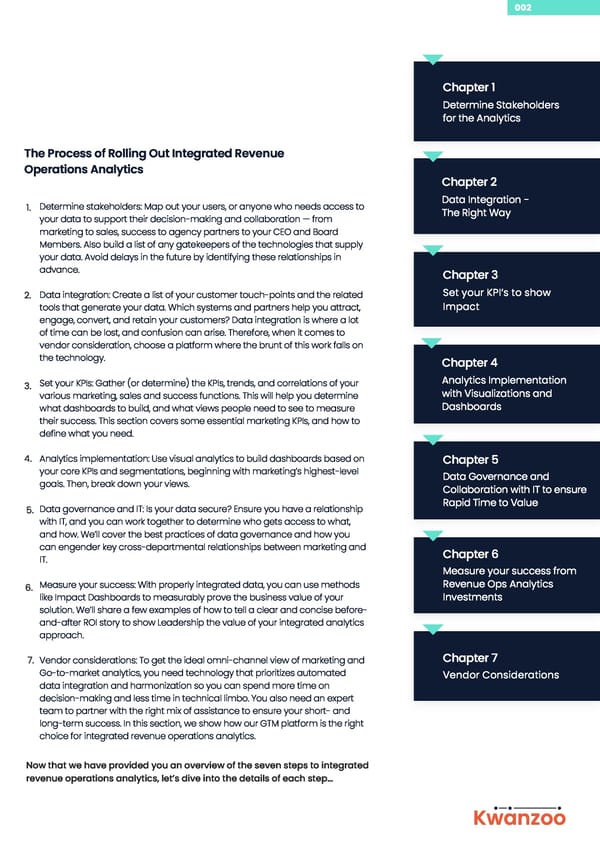002 Chapter 1 Determine Stakeholders for the Analytics The Process of Rolling Out Integrated Revenue Operations Analytics Chapter 2 Data Integration - Determine stakeholders: Map out your users, or anyone who needs access to 1. The Right Way your data to support their decision-making and collaboration — from marketing to sales, success to agency partners to your CEO and Board Members. Also build a list of any gatekeepers of the technologies that supply your data. Avoid delays in the future by identifying these relationships in advance. Chapter 3 Set your KPI’s to show Data integration: Create a list of your customer touch-points and the related 2. Impact tools that generate your data. Which systems and partners help you attract, engage, convert, and retain your customers? Data integration is where a lot of time can be lost, and confusion can arise. Therefore, when it comes to vendor consideration, choose a platform where the brunt of this work falls on the technology. Chapter 4 Analytics Implementation Set your KPIs: Gather (or determine) the KPIs, trends, and correlations of your 3. with Visualizations and various marketing, sales and success functions. This will help you determine Dashboards what dashboards to build, and what views people need to see to measure their success. This section covers some essential marketing KPIs, and how to define what you need. 4. Analytics implementation: Use visual analytics to build dashboards based on Chapter 5 your core KPIs and segmentations, beginning with marketing’s highest-level Data Governance and goals. Then, break down your views. Collaboration with IT to ensure Rapid Time to Value Data governance and IT: Is your data secure? Ensure you have a relationship 5. with IT, and you can work together to determine who gets access to what, and how. We’ll cover the best practices of data governance and how you can engender key cross-departmental relationships between marketing and Chapter 6 IT. Measure your success from Revenue Ops Analytics Measure your success: With properly integrated data, you can use methods 6. like Impact Dashboards to measurably prove the business value of your Investments solution. We’ll share a few examples of how to tell a clear and concise before- and-after ROI story to show Leadership the value of your integrated analytics approach. Chapter 7 7. Vendor considerations: To get the ideal omni-channel view of marketing and Go-to-market analytics, you need technology that prioritizes automated Vendor Considerations data integration and harmonization so you can spend more time on decision-making and less time in technical limbo. You also need an expert team to partner with the right mix of assistance to ensure your short- and long-term success. In this section, we show how our GTM platform is the right choice for integrated revenue operations analytics. Now that we have provided you an overview of the seven steps to integrated revenue operations analytics, let’s dive into the details of each step… Kwanzoo
 2. Revenue Operations Analytics Page 2 Page 4
2. Revenue Operations Analytics Page 2 Page 4